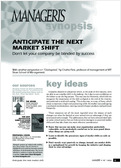The Upside

Key recommendations to develop a proactive attitude in front of the main strategic risks.
Author(s): Karl Weber, Adrian J. Slywotzky
Publisher: Crown Business
Date of publication: 2007
Manageris opinion
This book discusses what are known as “strategic” risks, that is, risks that jeopardize the very survival of a company, as opposed to mere operational or financial risks. The author points out that – contrary to common belief – successful firms tend to be the most vulnerable. This is why he recommends anticipating strategic risks by developing a proactive attitude toward detecting early warning signs and mitigating the risks connected with the company’s positions (final chapter).
The author identifies seven main forms of strategic risk, which are each covered by a separate chapter.
– In chapter 1, devoted to ""project-related risk,"" you will discover that teams too often tend to overestimate their chances of success and therefore do not take all the measures required to anticipate problems. ""Change your work habits,"" is the author’s watchword, illustrated by the famous Toyota hybrid vehicle project!
– Another major risk is ""customer-related risk"" (chapter 2). The author proposes ways to avoid the devastating effects of behavioral changes and to be more attentive to new needs. The Coach leather goods example provides a particularly good illustration of this principle in action.
– Sometimes, complete market maturity is the risk that you must face (chapter 3), for example when a new technology or a new business model emerges. Microsoft was confronted with such a situation with the rise of the Internet, for instance.
– If you are confronted with great competitive pressure, and notably the appearance of a single powerful competitor who begins to steamroll the entire market, as Wal-Mart did in the retail distribution sector, chapter 4 will give you some good ideas on what to do.
– There is always the risk of brand aging, and chapter 5 offers some helpful – though not particularly earthshaking – suggestions on how to fight it.
– If you have the feeling that your sector is becoming a no-profit zone, as has happened in the electronics, aeronautics and automotive industries (chapter 6), it is probably time to attempt to identify new sources of value, specifically by challenging the traditional balance of power and by capitalizing fully on the potential for collaboration with your competitors.
– Finally, an insidious risk that often creeps up on companies unseen is lack of growth. Indeed, companies waste a lot of time searching for excuses before finally responding. Lasting solutions can be found by reinventing the offering and the business model (chapter 7).
